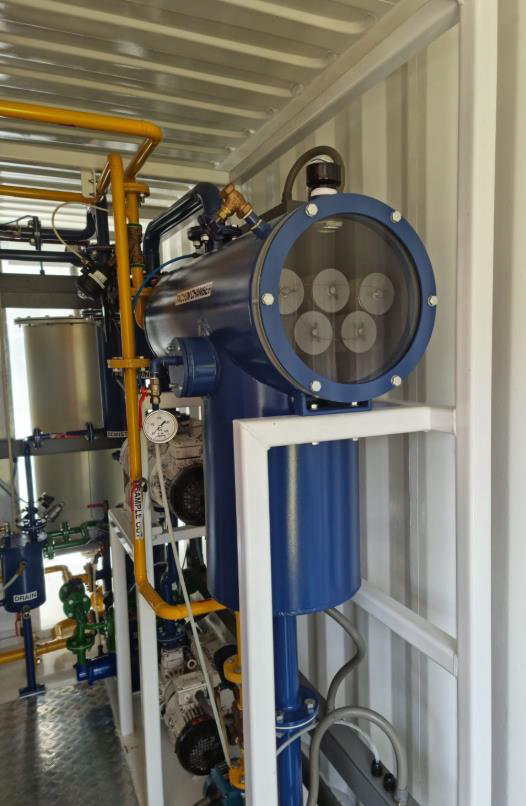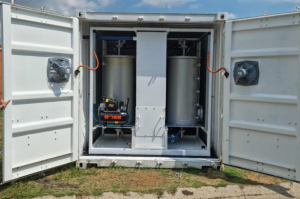WHY TRANSFORMER OIL REGENERATION & PURIFICATION?
When oil in a transformer reaches a stage (due to ageing process) where purification is no longer efficient, the oil must be changed or regenerated.
Regeneration is the complete treatment of oil to like new condition. Oil regeneration is a process whereby oil is processed to achieve a significant condition improvement, aimed at being as close to “as new” as possible, by removing the aging products. The processing is performed while a transformer is in service to achieve maximum effectiveness, with minimum impact to site operations.
The oil effects the insulation in the transformer and the insulation effects the oil, hence the condition of the oil impacts the expected life of the transformer. HVE solutions Transformer Oil Regeneration plant has been designed for the complete regeneration of transformer oil on a fixed site basis and treated oil will exceed quality requirement for new Transformer Insulating Oil.
HVE Solutions built our own Regeneration plant, and have provided the industry with regenerated oil for the last few years.
Difference between Oil Purification and Regeneration
Oil purification forms an important part of regular, preventative transformer maintenance. In the process of purification, water, dirt and gasses are removed from transformer oil. The oil leaving the plant will have improved dielectric strength.
When the oil in a transformer reaches a stage (due to aging process) where purification/degassing is no longer efficient, the oil must be changed or regenerated.
Regeneration is the complete treatment of oil and uses Fuller’s Earth to get the oil to a like new condition. The oil leaving the plant will have improved oxidation stability, colour, and reduced gassing tendency.

OUR PRODUCTS
TRANSFORMER OIL PURIFICATION PLANTS:
The regular purification of electrical insulating fluids is necessary to ensure longevity of your transformer. Moisture, solids and Gaseous contamination can seriously affect the function of electrical insulating fluids as a coolant and insulator. HVE SOLUTIONS offers a process of oil treatment focusing on using the latest technology to suit your needs.
TRANSFORMER OIL REGENERATION PLANTS
Regular regeneration treatments every eight to twelve years for each transformer in your network offers significant benefits.
- Reduced risk of unplanned outage and costly downtime
- Reduced maintenance costs.
- Extended equipment life
MOBILE REGENERATION UNIT
REGENERATING OIL VERSUS REPLACING OIL
The norm for many Power Utilities has been to simply replace the Transformer Oil once it has reached the end of its useful life. Besides being an expensive option, it is not environmentally friendly and is not in the best interests of the transformers wellbeing:
NEW OIL
- There is a limited supply of Virgin Transformer Oil available and the price is sensitive to this fact. The latest quoted price for oil is approximately US$ 2,15 per liter.
- Flushing Down a dirty transformer reaches only 10 – 15% of the interior surface.
- Changing Oil does not remove the deposited sludge on the core and coils, therefore it is not a solution to the problem, as this sludge mixes with the new oil.
- Disposal of the ‘changed out’ oil is now also a problem.
- A small amount of badly oxidised oil can ruin very large quantities of new oil.
- The disposal of old oil is potentially an environmental risk with spillage and PCB contamination a common occurrence.
REGENERATED OIL
- HVE Solutions plant can operate on an Energised Transformer, therefore there is no power supply interruption and no loss of revenue.
- No environmental hazard due to oil spillage or PCB contamination
- No exposure of the core to the atmosphere
- Not dependent on climatic conditions
- Complete flushing of transformer and core achieved
- The cost to Regenerate oil is far less than replacing the oil
- Oil Regeneration extends the transformers life.
PROCESS APPLICATIONS
The MRU is operationally very cost effective in a number of situations. Although the unit was designed so that it could be moved from one transformer site to another, the unit’s versatility and efficiency has not been compromised by its mobility :
On-site Regeneration (Regeneration of Oil in Transformers):
Before undertaking regeneration of transformer oil on-site, a sample of the oil will have been fully tested. The results of the test sample will determine to some extent, the regeneration, and its parameters, but the gas analysis in particular will determine whether the transformer can be treated in the energized or de-energized state. In both cases however, the oil in the transformer is re-circulated for period of time through the MRU.
- Energized :-The flow-rate with energized transformers is variable depending on transformer size, and the number of cycles is dependent on degree of contamination (acidity, sludge etc..) However, regeneration on site will require 8-12 passes through the MRU.
- De-energized :- Turbulence is not such an important factor with de-energized transformers and consequently the oil flow rate through the MRU can be increased to the maximum.
- De-sludging : – De-sludging takes place at a higher temperature than oil regeneration. The 2 most important criteria for de-sludging to take place are :
- The temperature of the oil in circulation through the transformer must be over its aniline point of about 78°C, in order to redissolve the sludge and
- Oil supplied to transformer the during circulation must be freshly regenerated to be able to dissolve and absorb sludge.
Desludging of the transformer can be carried out in the energized and de-energized state.
Notes :
- Sludge precipitated out of oil is re-dissolved in the same hot transformer oil. The temperature at which the sludge becomes “Soluble” is indicated by the aniline point of the oil.
- IFT should be > 40 dynes/cm
- Energized : – The process is very efficient and is aided by the slight mechanical vibration and heat
generated by the energized transformer. Between 30-60 passes may be necessary to complete the
task. - De-energized : – Less efficient than Energized above and de-sludging takes longer, depending on the sizeof the transformer.
- Tank-to-Tank Regeneration:– To utilize Fuller’s Earth to the best efficiency flow should be reduced
to 20- 25% of the nominal (full) flow.
DUTY & PERFORMANCE
Plant Efficiency:- High and consistent efficiency of MRU Ensures complete treatment of oil (being it in a transformer or in a single pass operation) to comply with IEC publication 296 for new oils.
Plant Capacity:– Capacities (See Flow Schematic) is based on initial acidity of 0,2mg KOH/g of oil. At different initial acidity, new capacity will be in inverse proportion to new initial acidity



